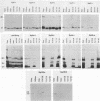Abstract
Six plaque-purified strains of Rickettsia tsutsugamushi (Karp, Gilliam, Kato, JC472B, TA716, and TA763) that fall into three categories of virulence for mice were compared by several parameters. Five of the six strains formed plaques of identical size in mouse cells, but each of three strains tested (representing three mouse virulence types) had a different doubling time in mouse cell cultures. Neither of these properties correlated strictly with virulence in mice, although the avirulent TA716 strain replicated much more slowly than the more virulent Karp and Gilliam strains. R. tsutsugamushi strain heterogeneity was also manifested at the polypeptide level by migration rates in sodium dodecyl sulfate-polyacrylamide gels of three of the major scrub typhus antigens (Sta110, Sta56, and Sta47), with those of Sta110 differing most widely. As expected, immunoblotting with polyclonal mouse sera showed substantial cross-reactivity among the major antigens of the six strains. Similar tests with Karp-induced monoclonal antibodies (MAb) demonstrated that some epitopes on Sta110 and Sta56 were shared by fewer than the six strains, but they identified no epitope unique to Karp. In contrast to the ready demonstration of antigenic heterogeneity in Sta110 and Sta56, four of the five Sta47-specific MAb reacted well with Sta47 from each of the six strains; the remaining MAb bound Sta47 from Karp and the Karp-like JC472B strain more strongly than Sta47 from the other four strains. The MAb also were useful in indicating the possible occurrence of Sta47 as dimers and trimers, the presence of Sta110 (as well as Sta56 and Sta47) in the rickettsial membrane, and the apparent interaction of the putative heat shock protein Sta58 with Sta47 or Sta47-Sta56 complexes.
Full text
PDF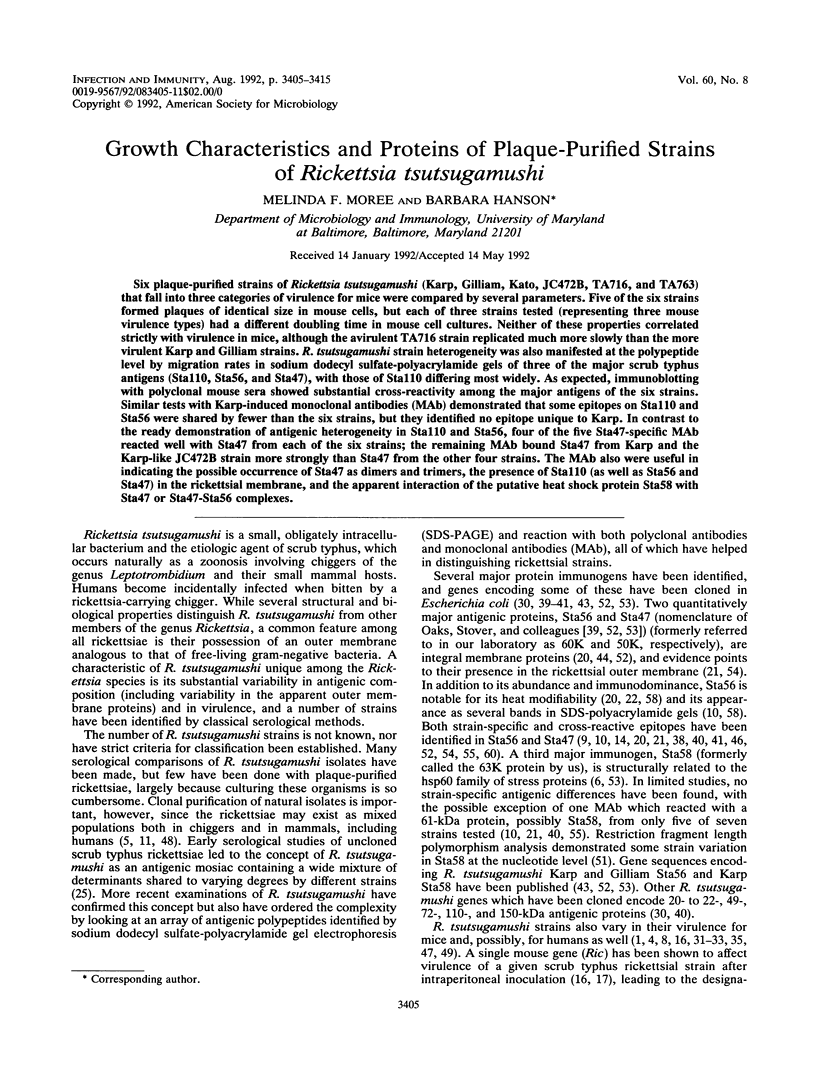
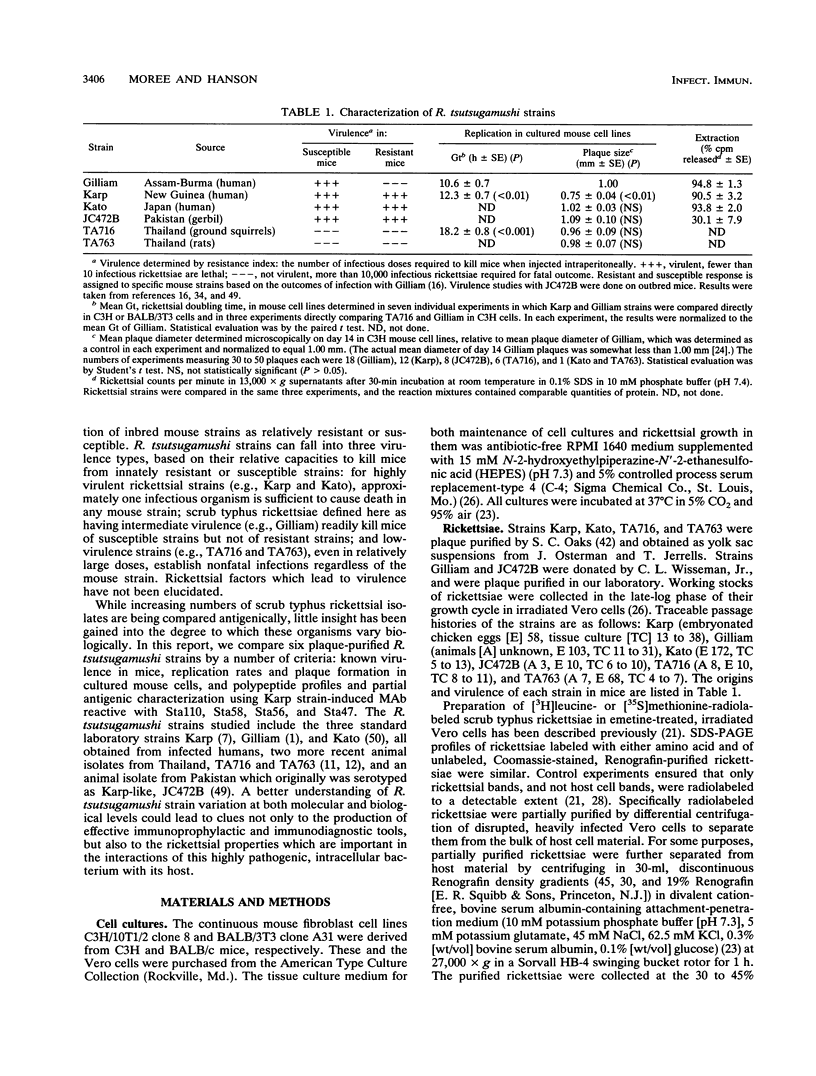

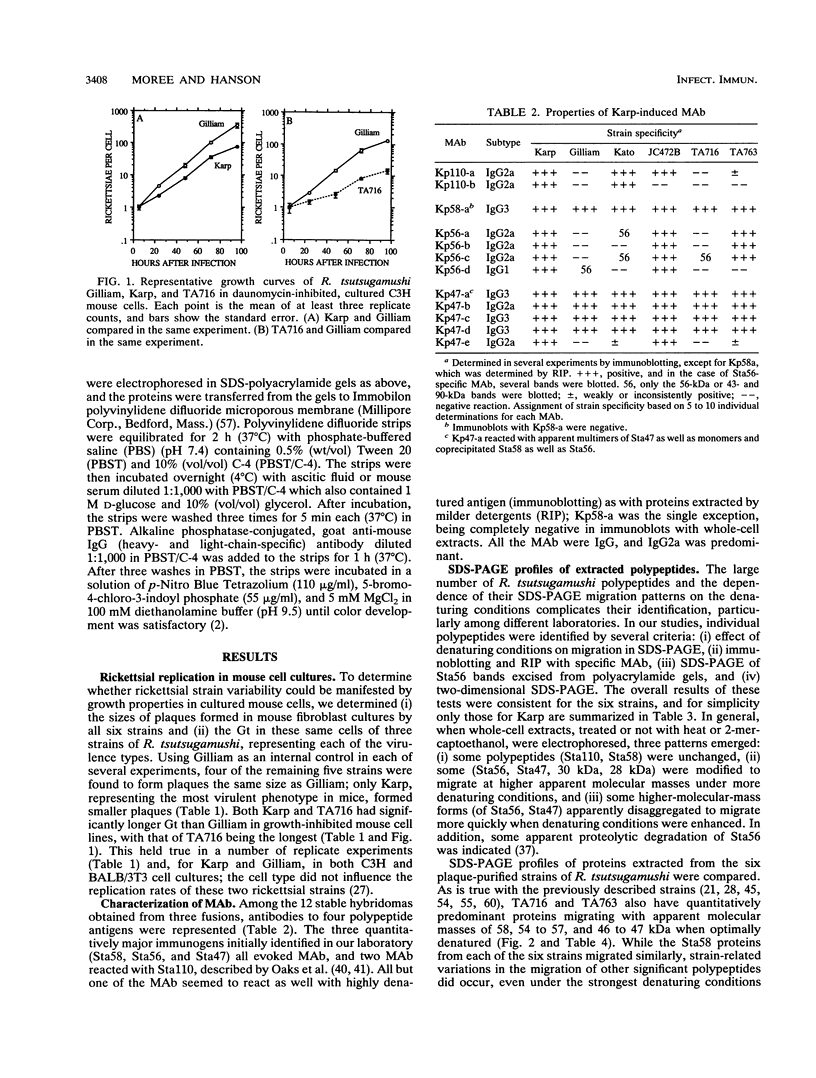
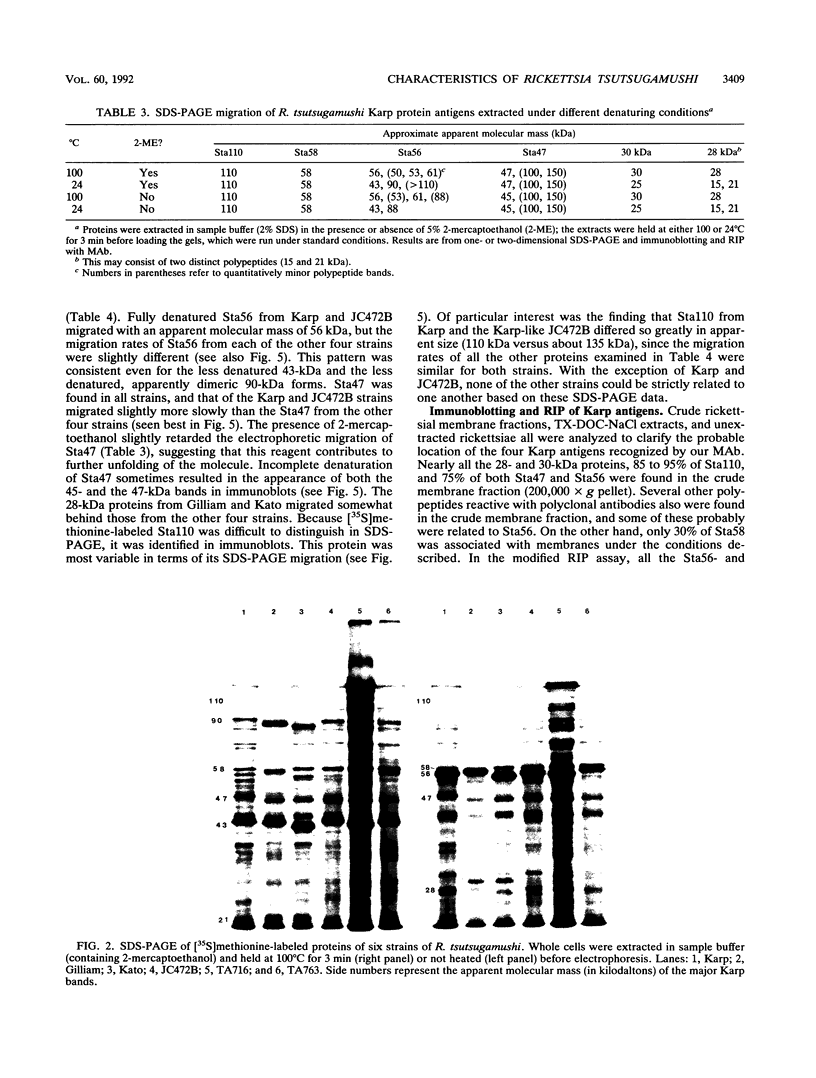
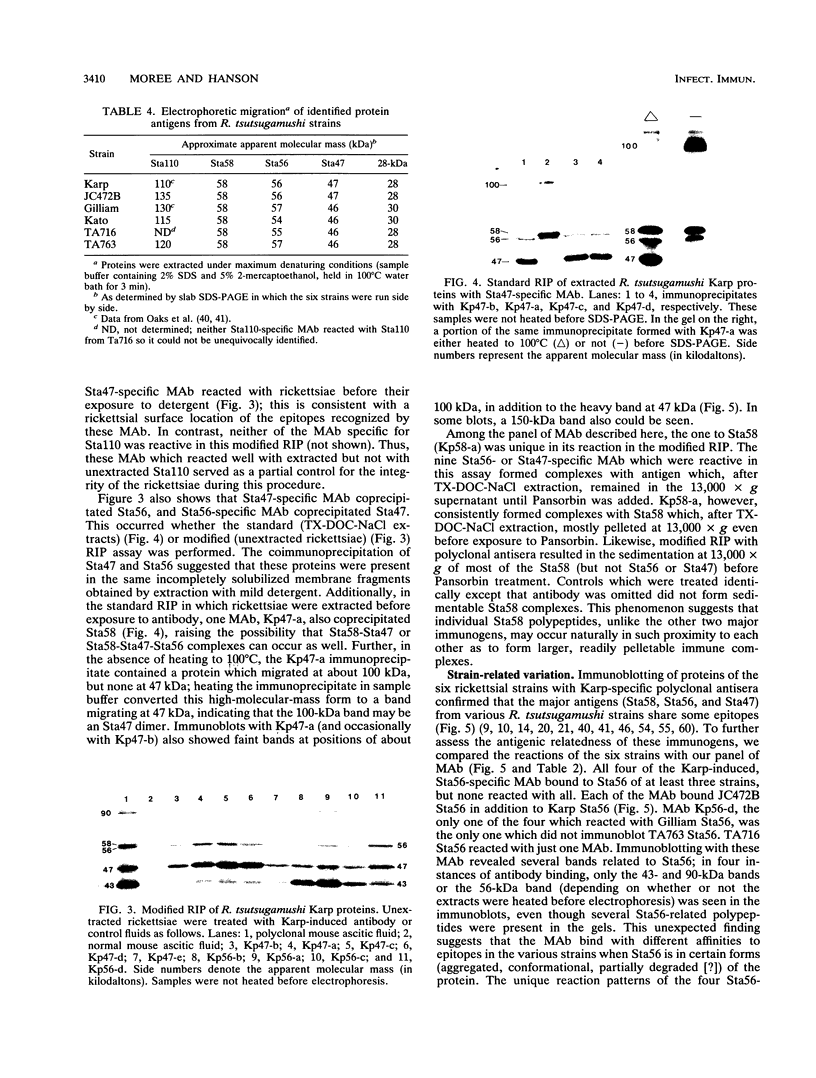
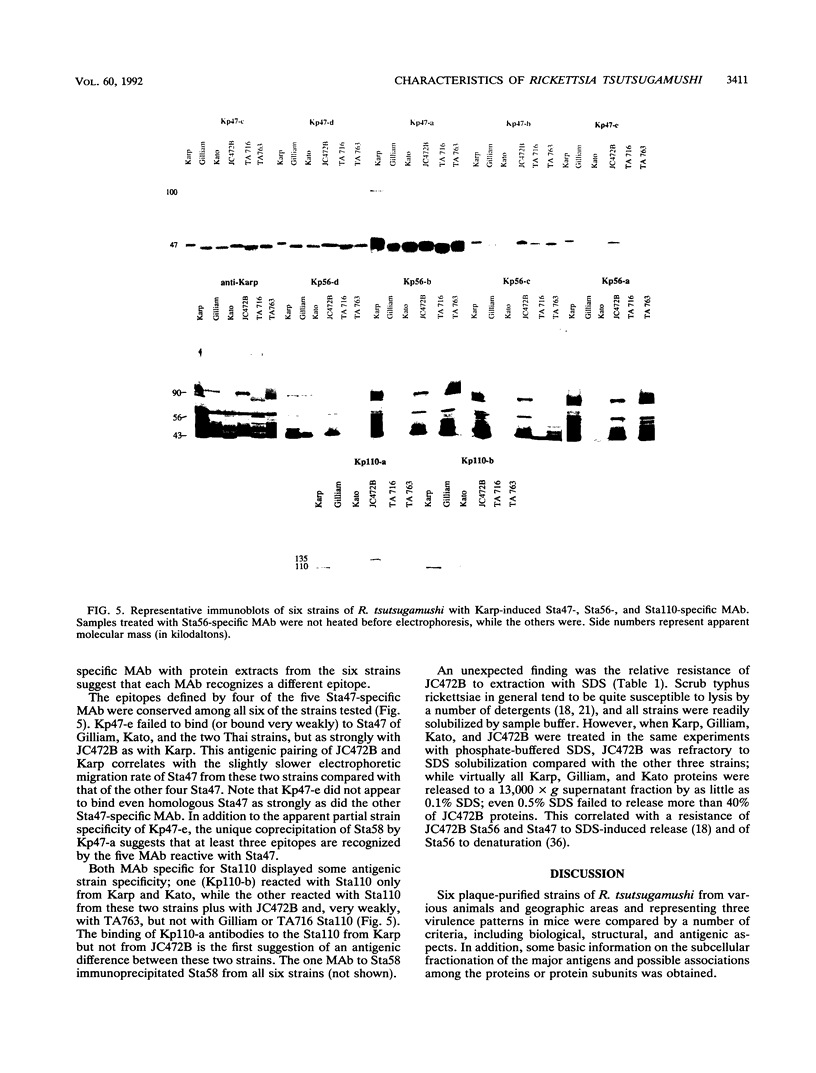
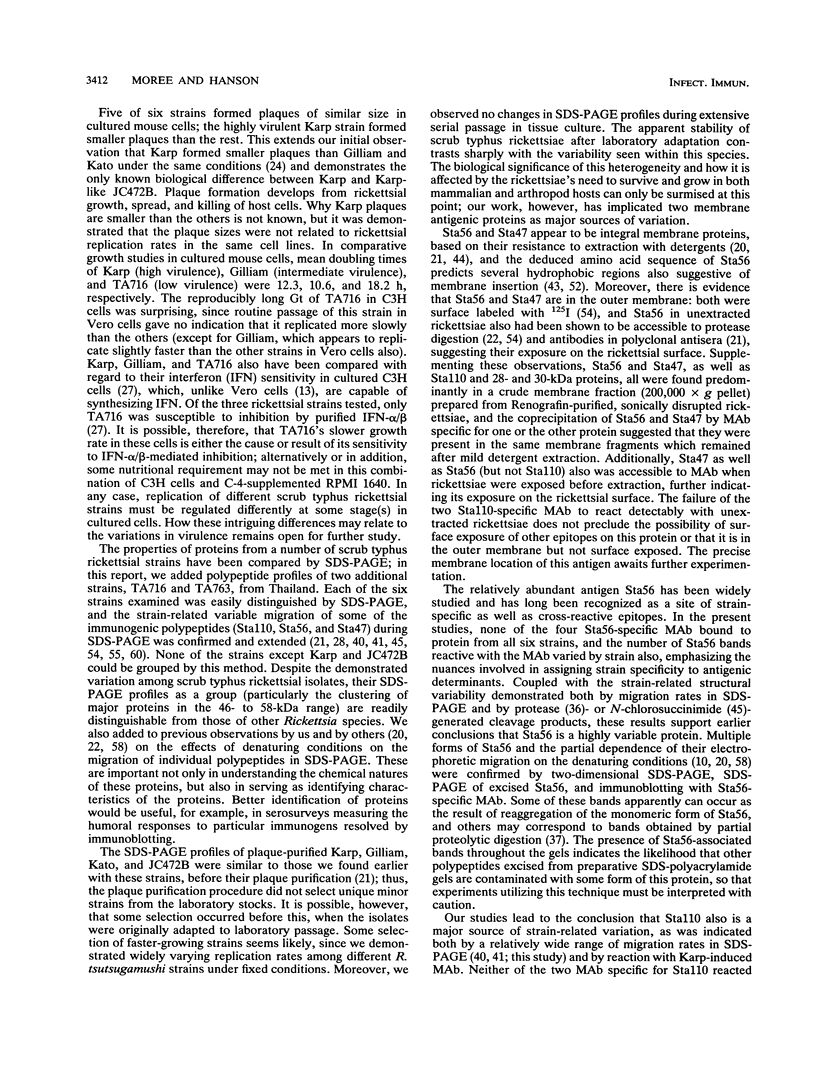
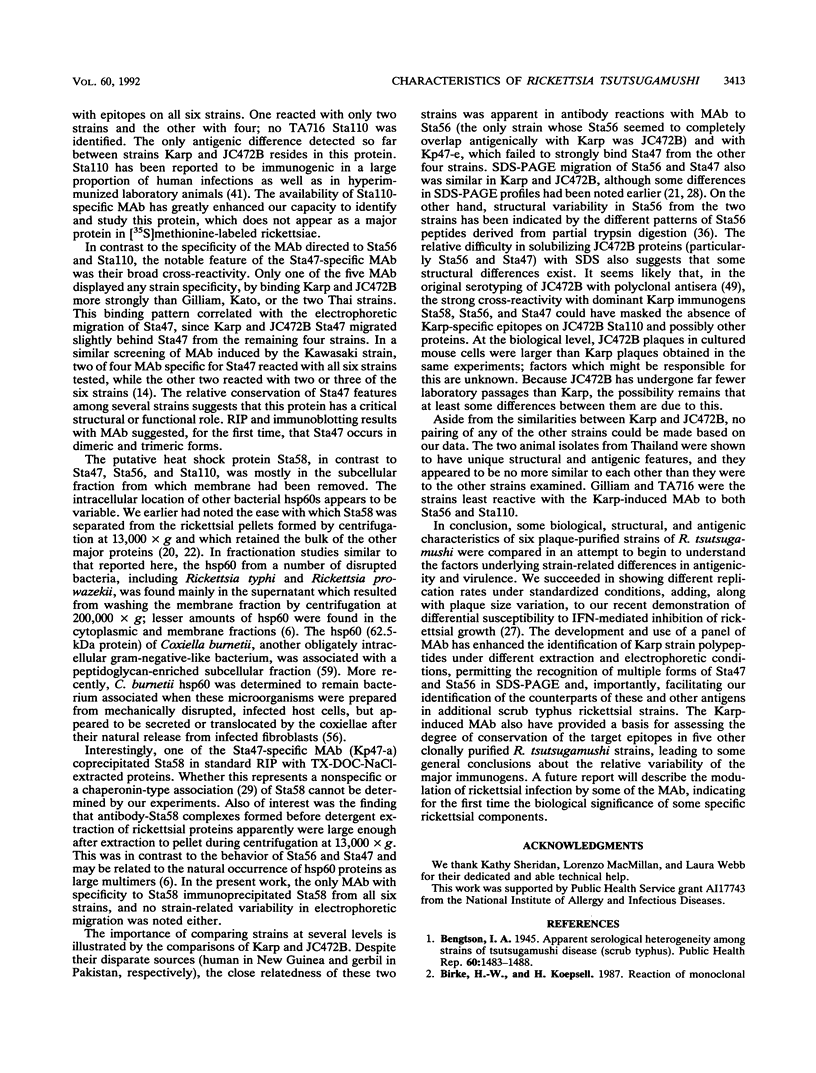
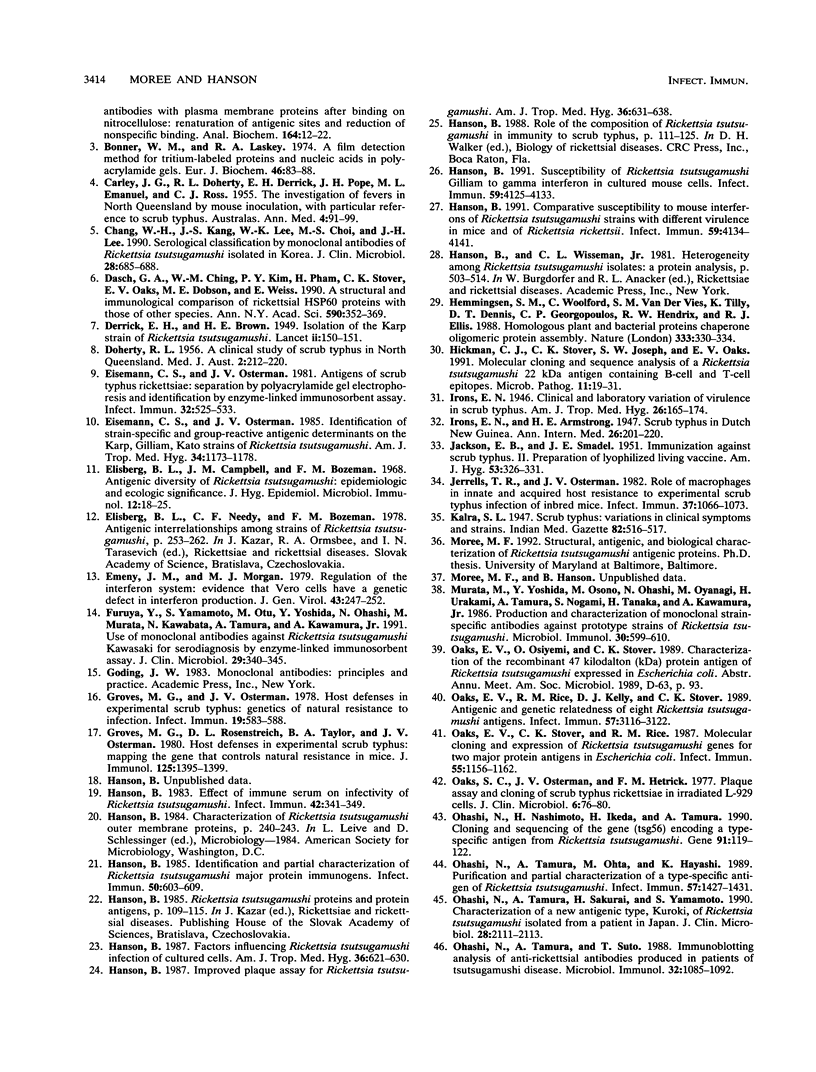
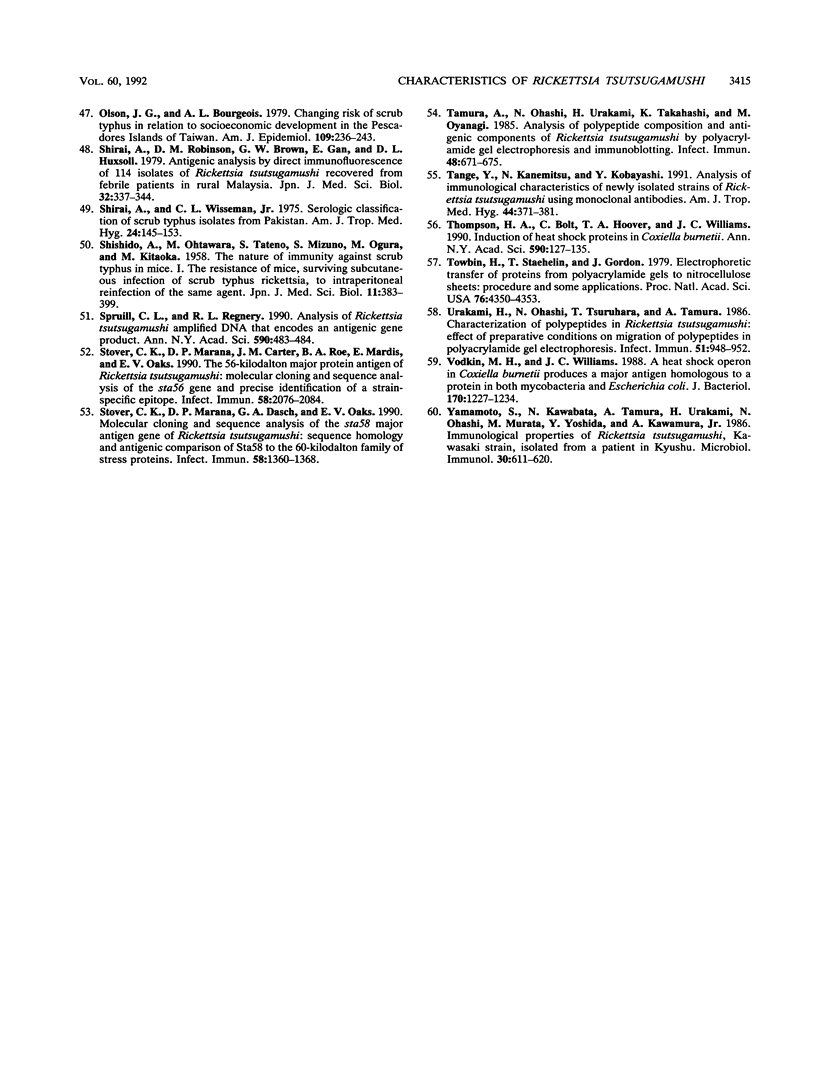
Images in this article
Selected References
These references are in PubMed. This may not be the complete list of references from this article.
- Bonner W. M., Laskey R. A. A film detection method for tritium-labelled proteins and nucleic acids in polyacrylamide gels. Eur J Biochem. 1974 Jul 1;46(1):83–88. doi: 10.1111/j.1432-1033.1974.tb03599.x. [DOI] [PubMed] [Google Scholar]
- CARLEY J. G., DOHERTY R. L., DERRICK E. H., POPE J. H., EMANUEL M. L., ROSS C. J. The investigation of fevers in North Queensland by mouse inoculation, with particular reference to scrub typhus. Australas Ann Med. 1955 May;4(2):91–99. doi: 10.1111/imj.1955.4.2.91. [DOI] [PubMed] [Google Scholar]
- Chang W. H., Kang J. S., Lee W. K., Choi M. S., Lee J. H. Serological classification by monoclonal antibodies of Rickettsia tsutsugamushi isolated in Korea. J Clin Microbiol. 1990 Apr;28(4):685–688. doi: 10.1128/jcm.28.4.685-688.1990. [DOI] [PMC free article] [PubMed] [Google Scholar]
- DOHERTY R. L. A clinical study of scrub typhus in North Queensland. Med J Aust. 1956 Aug 11;43(6):212–220. doi: 10.5694/j.1326-5377.1956.tb56591.x. [DOI] [PubMed] [Google Scholar]
- Dasch G. A., Ching W. M., Kim P. Y., Pham H., Stover C. K., Oaks E. V., Dobson M. E., Weiss E. A structural and immunological comparison of rickettsial HSP60 antigens with those of other species. Ann N Y Acad Sci. 1990;590:352–369. doi: 10.1111/j.1749-6632.1990.tb42242.x. [DOI] [PubMed] [Google Scholar]
- Eisemann C. S., Osterman J. V. Antigens of scrub typhus rickettsiae: separation by polyacrylamide gel electrophoresis and identification by enzyme-linked immunosorbent assay. Infect Immun. 1981 May;32(2):525–533. doi: 10.1128/iai.32.2.525-533.1981. [DOI] [PMC free article] [PubMed] [Google Scholar]
- Eisemann C. S., Osterman J. V. Identification of strain-specific and group-reactive antigenic determinants on the Karp, Gilliam and Kato strains of Rickettsia tsutsugamushi. Am J Trop Med Hyg. 1985 Nov;34(6):1173–1178. doi: 10.4269/ajtmh.1985.34.1173. [DOI] [PubMed] [Google Scholar]
- Elisberg B. L., Campbell J. M., Bozeman F. M. Antigenic diversity of rickettsia tsutsugamushi: epidemiologic and ecologic significance. J Hyg Epidemiol Microbiol Immunol. 1968;12(1):18–25. [PubMed] [Google Scholar]
- Emeny J. M., Morgan M. J. Regulation of the interferon system: evidence that Vero cells have a genetic defect in interferon production. J Gen Virol. 1979 Apr;43(1):247–252. doi: 10.1099/0022-1317-43-1-247. [DOI] [PubMed] [Google Scholar]
- Furuya Y., Yamamoto S., Otu M., Yoshida Y., Ohashi N., Murata M., Kawabata N., Tamura A., Kawamura A., Jr Use of monoclonal antibodies against Rickettsia tsutsugamushi Kawasaki for serodiagnosis by enzyme-linked immunosorbent assay. J Clin Microbiol. 1991 Feb;29(2):340–345. doi: 10.1128/jcm.29.2.340-345.1991. [DOI] [PMC free article] [PubMed] [Google Scholar]
- Groves M. G., Osterman J. V. Host defenses in experimental scrub typhus: genetics of natural resistance to infection. Infect Immun. 1978 Feb;19(2):583–588. doi: 10.1128/iai.19.2.583-588.1978. [DOI] [PMC free article] [PubMed] [Google Scholar]
- Groves M. G., Rosenstreich D. L., Taylor B. A., Osterman J. V. Host defenses in experimental scrub typhus: mapping the gene that controls natural resistance in mice. J Immunol. 1980 Sep;125(3):1395–1399. [PubMed] [Google Scholar]
- Hanson B. A. Effect of immune serum on infectivity of Rickettsia tsutsugamushi. Infect Immun. 1983 Oct;42(1):341–349. doi: 10.1128/iai.42.1.341-349.1983. [DOI] [PMC free article] [PubMed] [Google Scholar]
- Hanson B. Comparative susceptibility to mouse interferons of Rickettsia tsutsugamushi strains with different virulence in mice and of Rickettsia rickettsii. Infect Immun. 1991 Nov;59(11):4134–4141. doi: 10.1128/iai.59.11.4134-4141.1991. [DOI] [PMC free article] [PubMed] [Google Scholar]
- Hanson B. Factors influencing Rickettsia tsutsugamushi infection of cultured cells. Am J Trop Med Hyg. 1987 May;36(3):621–630. doi: 10.4269/ajtmh.1987.36.621. [DOI] [PubMed] [Google Scholar]
- Hanson B. Identification and partial characterization of Rickettsia tsutsugamushi major protein immunogens. Infect Immun. 1985 Dec;50(3):603–609. doi: 10.1128/iai.50.3.603-609.1985. [DOI] [PMC free article] [PubMed] [Google Scholar]
- Hanson B. Improved plaque assay for Rickettsia tsutsugamushi. Am J Trop Med Hyg. 1987 May;36(3):631–638. doi: 10.4269/ajtmh.1987.36.631. [DOI] [PubMed] [Google Scholar]
- Hanson B. Susceptibility of Rickettsia tsutsugamushi Gilliam to gamma interferon in cultured mouse cells. Infect Immun. 1991 Nov;59(11):4125–4133. doi: 10.1128/iai.59.11.4125-4133.1991. [DOI] [PMC free article] [PubMed] [Google Scholar]
- Hemmingsen S. M., Woolford C., van der Vies S. M., Tilly K., Dennis D. T., Georgopoulos C. P., Hendrix R. W., Ellis R. J. Homologous plant and bacterial proteins chaperone oligomeric protein assembly. Nature. 1988 May 26;333(6171):330–334. doi: 10.1038/333330a0. [DOI] [PubMed] [Google Scholar]
- Hickman C. J., Stover C. K., Joseph S. W., Oaks E. V. Molecular cloning and sequence analysis of a Rickettsia tsutsugamushi 22 kDa antigen containing B- and T-cell epitopes. Microb Pathog. 1991 Jul;11(1):19–31. doi: 10.1016/0882-4010(91)90090-w. [DOI] [PubMed] [Google Scholar]
- JACKSON E. B., SMADEL J. E. Immunization against scrub typhus. II. Preparation of lyophilized living vaccine. Am J Hyg. 1951 May;53(3):326–331. doi: 10.1093/oxfordjournals.aje.a119457. [DOI] [PubMed] [Google Scholar]
- Jerrells T. R., Osterman J. V. Role of macrophages in innate and acquired host resistance to experimental scrub typhus infection of inbred mice. Infect Immun. 1982 Sep;37(3):1066–1073. doi: 10.1128/iai.37.3.1066-1073.1982. [DOI] [PMC free article] [PubMed] [Google Scholar]
- Murata M., Yoshida Y., Osono M., Ohashi N., Oyanagi M., Urakami H., Tamura A., Nogami S., Tanaka H., Kawamura A., Jr Production and characterization of monoclonal strain-specific antibodies against prototype strains of Rickettsia tsutsugamushi. Microbiol Immunol. 1986;30(7):599–610. doi: 10.1111/j.1348-0421.1986.tb02987.x. [DOI] [PubMed] [Google Scholar]
- Oaks E. V., Rice R. M., Kelly D. J., Stover C. K. Antigenic and genetic relatedness of eight Rickettsia tsutsugamushi antigens. Infect Immun. 1989 Oct;57(10):3116–3122. doi: 10.1128/iai.57.10.3116-3122.1989. [DOI] [PMC free article] [PubMed] [Google Scholar]
- Oaks E. V., Stover C. K., Rice R. M. Molecular cloning and expression of Rickettsia tsutsugamushi genes for two major protein antigens in Escherichia coli. Infect Immun. 1987 May;55(5):1156–1162. doi: 10.1128/iai.55.5.1156-1162.1987. [DOI] [PMC free article] [PubMed] [Google Scholar]
- Oaks S. C., Jr, Osterman J. V., Hetrick F. M. Plaque assay and cloning of scrub typhus rickettsiae in irradiated L-929 cells. J Clin Microbiol. 1977 Jul;6(1):76–80. doi: 10.1128/jcm.6.1.76-80.1977. [DOI] [PMC free article] [PubMed] [Google Scholar]
- Ohashi N., Nashimoto H., Ikeda H., Tamura A. Cloning and sequencing of the gene (tsg56) encoding a type-specific antigen from Rickettsia tsutsugamushi. Gene. 1990 Jul 2;91(1):119–122. doi: 10.1016/0378-1119(90)90171-m. [DOI] [PubMed] [Google Scholar]
- Ohashi N., Tamura A., Ohta M., Hayashi K. Purification and partial characterization of a type-specific antigen of Rickettsia tsutsugamushi. Infect Immun. 1989 May;57(5):1427–1431. doi: 10.1128/iai.57.5.1427-1431.1989. [DOI] [PMC free article] [PubMed] [Google Scholar]
- Ohashi N., Tamura A., Sakurai H., Yamamoto S. Characterization of a new antigenic type, Kuroki, of Rickettsia tsutsugamushi isolated from a patient in Japan. J Clin Microbiol. 1990 Sep;28(9):2111–2113. doi: 10.1128/jcm.28.9.2111-2113.1990. [DOI] [PMC free article] [PubMed] [Google Scholar]
- Ohashi N., Tamura A., Suto T. Immunoblotting analysis of anti-rickettsial antibodies produced in patients of Tsutsugamushi disease. Microbiol Immunol. 1988;32(11):1085–1092. doi: 10.1111/j.1348-0421.1988.tb01473.x. [DOI] [PubMed] [Google Scholar]
- Olson J. G., Bourgeois A. L. Changing risk of scrub typhus in relation to socioeconomic development in the Pescadores islands of Taiwan. Am J Epidemiol. 1979 Feb;109(2):236–243. doi: 10.1093/oxfordjournals.aje.a112678. [DOI] [PubMed] [Google Scholar]
- Public Health Weekly Reports for DECEMBER 14, 1945. Public Health Rep. 1945 Dec 14;60(50):1483–1518. [PMC free article] [PubMed] [Google Scholar]
- Shirai A., Robinson D. M., Brown G. W., Gan E., Huxsoll D. L. Antigenic analysis by direct immunofluorescence of 114 isolates of Rickettsia tsutsugamushi recovered from febrile patients in rural Malaysia. Jpn J Med Sci Biol. 1979 Dec;32(6):337–344. doi: 10.7883/yoken1952.32.337. [DOI] [PubMed] [Google Scholar]
- Shirai A., Wisseman C. L., Jr Serologic classification of scrub typhus isolates from Pakistan. Am J Trop Med Hyg. 1975 Jan;24(1):145–153. doi: 10.4269/ajtmh.1975.24.145. [DOI] [PubMed] [Google Scholar]
- Spruill C. L., Regnery R. L. Analysis of Rickettsia tsutsugamushi amplified DNA that encodes an antigenic gene product. Ann N Y Acad Sci. 1990;590:483–484. doi: 10.1111/j.1749-6632.1990.tb42257.x. [DOI] [PubMed] [Google Scholar]
- Stover C. K., Marana D. P., Carter J. M., Roe B. A., Mardis E., Oaks E. V. The 56-kilodalton major protein antigen of Rickettsia tsutsugamushi: molecular cloning and sequence analysis of the sta56 gene and precise identification of a strain-specific epitope. Infect Immun. 1990 Jul;58(7):2076–2084. doi: 10.1128/iai.58.7.2076-2084.1990. [DOI] [PMC free article] [PubMed] [Google Scholar]
- Stover C. K., Marana D. P., Dasch G. A., Oaks E. V. Molecular cloning and sequence analysis of the Sta58 major antigen gene of Rickettsia tsutsugamushi: sequence homology and antigenic comparison of Sta58 to the 60-kilodalton family of stress proteins. Infect Immun. 1990 May;58(5):1360–1368. doi: 10.1128/iai.58.5.1360-1368.1990. [DOI] [PMC free article] [PubMed] [Google Scholar]
- Tamura A., Ohashi N., Urakami H., Takahashi K., Oyanagi M. Analysis of polypeptide composition and antigenic components of Rickettsia tsutsugamushi by polyacrylamide gel electrophoresis and immunoblotting. Infect Immun. 1985 Jun;48(3):671–675. doi: 10.1128/iai.48.3.671-675.1985. [DOI] [PMC free article] [PubMed] [Google Scholar]
- Tange Y., Kanemitsu N., Kobayashi Y. Analysis of immunological characteristics of newly isolated strains of Rickettsia tsutsugamushi using monoclonal antibodies. Am J Trop Med Hyg. 1991 Apr;44(4):371–381. doi: 10.4269/ajtmh.1991.44.371. [DOI] [PubMed] [Google Scholar]
- Thompson H. A., Bolt C. R., Hoover T., Williams J. C. Induction of heat-shock proteins in Coxiella burnetii. Ann N Y Acad Sci. 1990;590:127–135. doi: 10.1111/j.1749-6632.1990.tb42215.x. [DOI] [PubMed] [Google Scholar]
- Towbin H., Staehelin T., Gordon J. Electrophoretic transfer of proteins from polyacrylamide gels to nitrocellulose sheets: procedure and some applications. Proc Natl Acad Sci U S A. 1979 Sep;76(9):4350–4354. doi: 10.1073/pnas.76.9.4350. [DOI] [PMC free article] [PubMed] [Google Scholar]
- Urakami H., Ohashi N., Tsuruhara T., Tamura A. Characterization of polypeptides in Rickettsia tsutsugamushi: effect of preparative conditions on migration of polypeptides in polyacrylamide gel electrophoresis. Infect Immun. 1986 Mar;51(3):948–952. doi: 10.1128/iai.51.3.948-952.1986. [DOI] [PMC free article] [PubMed] [Google Scholar]
- Vodkin M. H., Williams J. C. A heat shock operon in Coxiella burnetti produces a major antigen homologous to a protein in both mycobacteria and Escherichia coli. J Bacteriol. 1988 Mar;170(3):1227–1234. doi: 10.1128/jb.170.3.1227-1234.1988. [DOI] [PMC free article] [PubMed] [Google Scholar]
- Yamamoto S., Kawabata N., Tamura A., Urakami H., Ohashi N., Murata M., Yoshida Y., Kawamura A., Jr Immunological properties of Rickettsia tsutsugamushi, Kawasaki strain, isolated from a patient in Kyushu. Microbiol Immunol. 1986;30(7):611–620. doi: 10.1111/j.1348-0421.1986.tb02988.x. [DOI] [PubMed] [Google Scholar]






